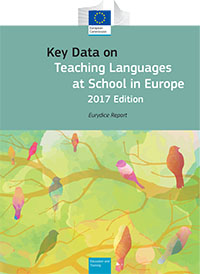indireinforma
The new report on the teaching of foreign languages in Europe has been released

More than 60 official languages are spoken in Europe, a continent with an extraordinary linguistic variety which is destined to increased due to the recent immigration flows. The 2017 edition of the Key Data on Teaching Languages at School in Europe, reports on the main educational policies concerning teaching and learning of foreign languages in 42 European educational systems.
This fourth edition is very rich of contents and includes 60 indicators organised in five chapters: context, organisation, participation, teachers and educational processes.
Different sources were used to draw up the report: qualitative and quantitative data respectively of Eurydice and Eurostat; and OCSE/PISA and TALIS international surveys. Eurydice data covers all the European Union countries and Bosnia- Erzegovina, Switzerland, Iceland, Liechtenstein, Montenegro, the former Yugoslav Republic of Macedonia, Norway, Serbia and Turkey.
Here is an overview of some of the main findings of the report:
- Students begin to learn a foreign language earlier than in the past.
In most countries, pupils begin learning a first foreign language as a compulsory subject between 6 and 7 years of age, that is in the early years of primary education. Italy is part of this group of countries, under the law 53/2003 which provided for compulsory teaching of the English language, from the first year of primary school (6 years of age). However, in many countries, the time dedicated to foreign languages, in primary school curricula, is rather modest. In most countries, this percentage varies from 5 to 10% of the total time.
- The study of a second foreign language is not mandatory in all countries
More and more students study a second foreign language at lower secondary school. In 2014, at EU level, 59.7% of all lower secondary school students studied two or more foreign languages. This was a remarkable increase compared to 2005, when the figure was 46.7% of students.
- English is the most studied foreign language
In almost all European countries, English is the most taught foreign language in primary and secondary education. At EU level, in 2014, almost all pupils (97.3%) studied English during lower secondary education. In addition, the percentage of pupils learning English at primary level increased at EU level by 18.7 percentage points since 2005, reaching 79.4%. French is the second most commonly studied foreign language in the lower secondary level, (33.3% of EU students in 2014). German is the third most popular foreign language (23.1%), followed by Spanish 13.1%.
- Students are required to reach the “Independent user level” in the first foreign language at the end of the school curriculum
Most countries use the Common European Framework of Reference for Languages (QCER), developed by the Council of Europe to define competence levels in foreign languages that are internationally comparable. At the end of upper secondary education, most countries require at least a B2 level (Upper intermediate – independent user) in the first foreign language. Several countries set a B1 level (Intermediate – independent user). Italy is one of the few countries that requires its students to have reached at least a B2 level at the end of upper secondary education, both for the first and for the second foreign language.
- The majority of European countries provide language support for newly-arrived immigrant students
Almost all countries provide additional language training courses for immigrant pupils and more than one third of European education systems offer these students personalised teaching or an individualised curriculum. Italy is part of this group of countries. Immigrant students’ full integration has been chosen as a priority, since the beginning. This objective can’t be accomplished without a good knowledge of Italian as a second language (L2).
Notice: on Thursday, June 15 (12:30 – 2pm), a webinar will be organised to launch this study. To join just click on this link on the appointed day.
What Eurydice is
Eurydice is the European network that collects, updates, analyses and disseminates information on the policies, structures and organisations of European education systems. Established in 1980 on the initiative of the European Commission, the network is made up of a European unit based in Brussels and various national units. Since 1985, Indire is home to the Italian National Unity.
Other useful links:
- Read the Key Data on Teaching Languages at School in Europe – 2017 Edition (pdf)
- Eurydice website – Italian National Unit
- Eurydice website – European Central Unit
- All publications of the European and Italian networks


